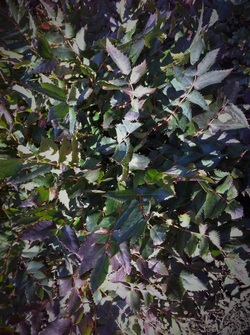 Of the two species of Oregon Grape on the property, this one (Mahonia nervosa) is the more shade tolerant and a nice patch of it grows under the densest patch of older Garry Oaks. The name refers to the matte finish of the leaves when compared to Tall Oregon Grape. Like that species, winter leaf colour varies and some individuals can have winter leaves of purples, reds and even brilliant scarlets. David Douglas; the botanist the Douglas-fir is named after, brought both species back to England for the gardens. Of the two, he preferred this one. I tend to agree, this species is very attractive, seldom requires cutting back, and, by merits of its shade tolerance, often is the answer to a difficult gardening problem - what to plant in dry shade? Berries of both species are edible and make great jelly, either alone or combined with salal berries.
0 Comments
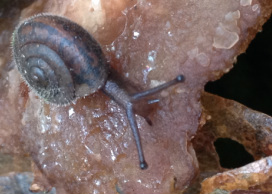 Look waaayy down, and under and behind and you will find a number of teensy tiny snails, including Vespericola columbianus. I think that I will need to learn how to put scale bars on these photos so you could see that the diameter of the shell is approximately 6 mm. Even at this small size, the fine covering of hairs is apparent and surprising to most. Snails are not thought of as furry and cuddly! The best place to find these is under leaf litter, logs and sword ferns. This one was on a piece of slimy mushroom (not identified!). If you are turned on by these wee, and sometimes not so wee critters, the best field guide is Robert Forsyth's Royal BC Museum handbook; "Land Snails of British Columbia". **Thanks very much to the local expert who caught my original misidentification of this critter. There is a somewhat similar small snail called Pygmy oregonian; Cryptomastix germana that I had mistaken this for. (Aug 11, 2014)  Dendroalsia abietina is an attractive and easily identified moss that grows on the trunks of Garry Oak and Big Leaf Maple here at Leaning Oaks. It is some times called Balsam Fir Moss since the fronds look like someone shingled the trunk of a tree with felt cut outs of tiny Christmas Trees. In the summer, this moss shrivels up and forms a dense mat on the trunk of the trees. Here it grows only when the trunk gets some shade, trees out in the open tend not to have large mats of this moss. Another common name, Plume Moss, is a bit ambiguous since a number of other mosses go by that common name as well. 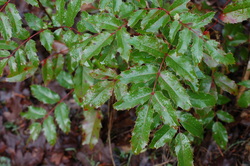 We have two native species of Oregon Grape growing on the property, this one, Mahonia aquifolium and the Dull Oregon Grape (M. nervosa). We grow a third species in the garden. Tall Oregon Grape has shiny leaves that look as if they are wet- hence the latin name, with smaller numbers of leaflets on each leaf. The leaves vary quite a bit from plant to plant in leaflet shape and in winter colour. Some plants have leaves that turn a nice burnished burgandy colour, while most stay green. Yellow flowers in early spring and blue berries in late summer make this a particularly attractive species. This is one of our natives that is used extensively in horticulture. I remember seeing large boulevard plantings of this when we visited Holland a few years ago. There are days when I feel a bit like I am living inside a cutesy Christmas card with the dozens of Chestnut-backed Chickadees (Poecile rufescens) that flit around the trees and swarm the suet year round. Soon it will be time to re-fill the old fat feeder with dog hair and fur that the chickadees will haul off in gobs to line the most luxurious, cozy nests ever! Many of these nests are in one of the several snags that we have created.
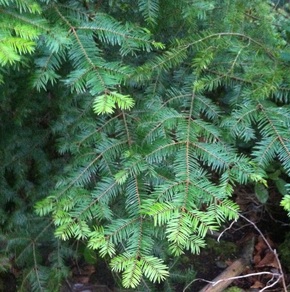 At Leaning Oaks, Grand Fir (Abies grandis) is represented by seedlings and sapling trees only, so far we have not found a mature tree on the property. Most of the property is too dry to support a mature Grand Fir and the saplings succumb to summer droughts. Grand Fir foliage is easily identified by its odour, when crushed the foliage smells like grapefruit. Our friend Jan Garnett put that to good use one dinner by making a palate-cleansing sorbet from Grand Fir needles - delicious!  Luckily we have very little Daphne on the property...but every once in a while a few plants pop up. These are quickly pulled! Not only can this plant by invasive and can out compete the native vegetation in undisturbed areas, but it is also toxic. According to the Invasive Species Council of BC (see link below), "the toxins are in the bark, sap and the berries, and if contacted, the sap is known to cause skin rashes, nausea, swelling of the tongue and coma". Nice. Perhaps I will wear gloves the next time that I pull any up! http://www.bcinvasives.ca/general/weed-of-the-week-daphnespurge-laurel  Sometimes a common name really does capture what a species looks like. Rhytidiadelphus triquestris is known by a number of common names (Shaggy Moss, Rough-neck Moss, Rough Goose-neck Moss), but this one captures the look of the moss perfectly. It is the dominant moss in the understory of our Douglas-fir stand here at Leaning Oaks and grows on rocks, mineral soil and over rotten logs and branches. I was sure that the "Old Man's Beard" that covers many of the Garry Oak branches would be easy to identify. Apparently not! I asked experts, cut at the cortex, studied the books.....and was happiest when I found that the "Macrolichens of the Pacific Northwest" by McCune and Geiser lumps a swack of similar ones as part of the Usnea filipendula group with a comment that it would be "futile to apply" a more specific species name until the taxonomy of the group is worked out. I will continue to try and identify it and post what I find.
The Golden-crowned Kinglets and other small birds love to forage amongst the branches, pulling out whatever wee arthropods they find there. To me, the festooned branches give the appearance of a long established forest and woodland. 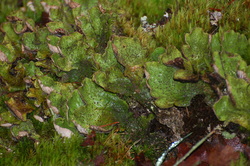 There are 3 species of these green (when wet) Peltigera in our area with black "freckles". This one, Peltigera brittanica is the commonest on the west coast and the Silver-edged Pelt, Peltigera aphthosa is the more common one in the interior of the province. The black "freckles" are cephalodia, which are cyanobacteria containing warts. In this species these growths are raised and free at the edges and easily brushed off (hence the "Deciduous" name, I assume). In Silver-edged and Ruffled Pelts (P. leucophlebia) they are recessed and rather more difficult to dislodge. In addition the Ruffled Pelt is shaded on the undersurface so that it is white on the edges and gradually changes to black in the center, while in the other two species the colour change is sharply demarked. At Leaning Oaks, Deciduous Pelt grows on rocks and boulders in open areas that have a moss cover. Other common names for this species include British Felt Lichen and the Flaky Freckle Pelt. It is very unusual if we go more than a few weeks without having at least one, and more often a pair of Great Horned Owls (Bubo virginianus) calling on or around the property. At this time of year there are duets between the higher pitched and persistent male and the bigger and lower pitched female. This family used the meadow and surrounding woods as their home a couple of years ago. They were very distracting! The rabbit population takes a hit when there are owls around, a fabulous form of biocontrol. On one memorable occasion a dinner party was interrupted by bunny screams as a Great Horned Owl took grabbed her dinner and then disemboweled the prey outside the window.
 We have two species of Snowberry here at Leaning Oaks. The taller of the two is this one, Common Snowberry (Symphoricarpos albus), which ironically, is the less common of the two. Here they don't always fruit, but when they do the white berries are a welcome sight on dreary winter days. In the spring they have small bell-shaped flowers which are often visited by bumble bees and both Rufous and Anna's Hummingbirds. Snowberries are the food plant for a number of native moth caterpillars including the dapper and unusual Snowberry Bee Hawk Moth (Hemerus diffinis) a daytime flying, bee mimic we most often see feeding on our Dwarf Liliac. Turn over woody debris or brush away the fallen oak and maple leaves, peer between the cracks of the mossy rock outcrops and you will find many types of snails. This is one of the larger species that lives in the forested areas, often near the base of the Douglas-fir or Big-leafed Maples. The yellow sideband of the Pacific Sideband (Monadenia fidelis) is highly variable in width, some being wider and obvious, others like this one narrow and tanny yellow. Thanks to Lea Gelling for confirming the identification.
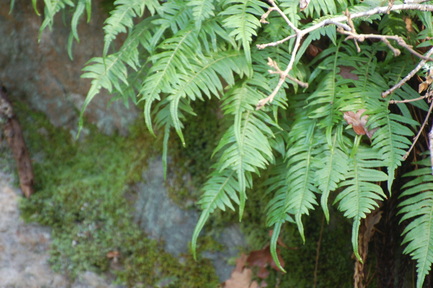 The predominant colour of Leaning Oaks during the winter months is green. The carpet of mosses that cover the rock outcrops and tree trunks green up, the winter annuals sprout and Licorice Fern (Polypodium glycyrrhiza) looks its best with the new foliage it started to produce in the fall. Most years the new growth starts with the first heavy rainfall in August or September. Here the species grows best on rock outcrops or Big-leaf Maple trunks up above the reach of Black-tailed Deer. The individuals that are below the browse line are small and stunted and never seem to be able to develop to their full potential. For tips on growing this species in a winter hanging basket (that you only have to plant once every twenty years or so) click on the button. 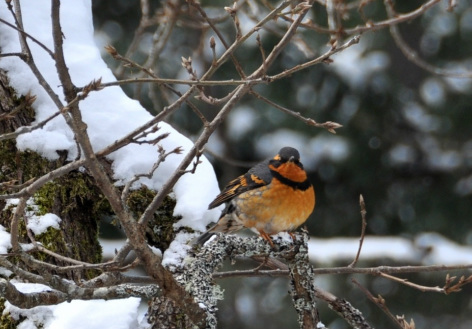 Varied Thrushes (Ixoreus naevius) usually arrive at Leaning Oaks in the first week of September, their presence made known by their train whistle song. They are here all winter through April, with a small number of birds lingering until the last week of May. Despite their noisy presence as part of the early spring dawn chorus, we have no breeding records for the property. Our best Varied Thrush viewing was the year that the winter residents figured out that if they came to the suet feeders when the Northern Flickers were there; the crumbs that rained down were easy pickings! They were totally tuned into the feeding of the flickers and would arrive within minutes to clean up. This was my first choice for the BC's official bird when the vote was on in 1987 -so elegant and much of its breeding range fits nicely with in the south and eastern borders of the province. Much better than the squawky Steller's Jay! 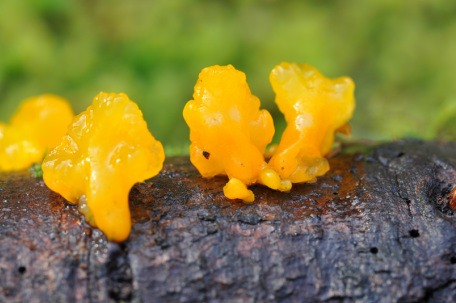 Orange Jelly on a Douglas-fir branch. . Orange Jelly on a Douglas-fir branch. . When I was a park naturalist one of the activities we used to do with school groups was to hand out small pieces of brightly coloured paint chips, in an array of gaudy and improbable colours. Each student was sent into the forest with the goal of finding some organism that had as close a match to their colour as possible. If we were doing this with a group in the fall, students would often find this fungus to match yellow or orange colours. Dacrymces chrysospermus (most field guides call this D. palmatus) is one of a number of orange jelly fungi found on southern Vancouver Island. Here at Leaning Oaks it almost always grows on Douglas-fir wood that is just starting to decay. It starts out bright yellow and becomes a rich tangerine orange before almost disappearing completely as a tan scum (see photo below for a very young and almost dried up fruiting body). A very useful key to the local jelly fungus can be found at http://www.svims.ca/council/Jelly.htm#nYel As much as we'd love to say that we have a pristine piece of land without aliens...of course it is not true. The Eastern Grey Squirrel (Sciurus carolinensis) was introduced to Vancouver Island in 1966 via a zoo in Metchosin. From that time they have expanded throughout southern Vancouver Island and north past Nanaimo along the east coast. They love the Garry Oak acorns , the spilled bird feed and suet and teasing the dogs. We have done some modest attempts at control and at one point were rewarded with a native Red Squirrel (Tamiasciurus hudsonicus), however we were unable to sustain the control. There is more on this invasive from the Garry Oak Ecosystem Recovery Team: http://www.goert.ca/documents/InvFS_sciucaro.pdf
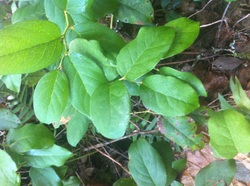 Salal (Gaultheria shallon) is found at Leaning Oaks in scattered patches and we retained many of them when we were developing the garden here. With their evergreen leathery leaves, and edible berry, they are valuable landscape plants, growing in both sun and shade and requiring no supplemental watering. The berry makes an excellent jam/jelly with a foxy flavour that pairs well with game meats and as jam on toast. Salal was an important plant in our family when we were growing up. Our parents, as well as us boys, made extra pocket money picking salal on Salt Spring Island for commercial buyers based out of the Cowichan Valley. I still can't walk past a stand of salal without looking for those prized stems that had a flat spray of evenly spaced, blemish-free leaves. The smell of bundles of salal that were brought into the basement so they could be sorted and carefully picked over so that blemished or torn leaves could be taken off the stems is one of those smells of my childhood. 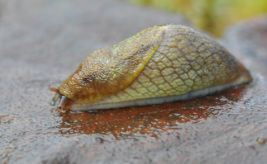 This pretty slug; the Yellow-bordered Taildropper (Prophysaon folioatum) is the largest of the taildroppers that we have on southern Vancouver Island. This genus of slugs have a line of defense where if a beetle or other predator grabs at its "tail", it will excise the back end! Apparently they gush out more slime at the front end in order to convince the predator that the back end is the place to be. I found a number of these while looking for the much rarer Blue-grey Taildropper. Here is a handy ID guide: http://www.hat.bc.ca/attachments/Blue-grey%20Taildropper%20ID%20Guide%20HAT%203.pdf  The Dark-eyed Junco (Junco hyemalis) is the commonest bird here at Leaning Oaks, with thirty or more birds using the feeders during the winter and more than ten pairs nesting on the property during the breeding season. The nests are usually on the ground, on low stumps or in one or more of our hanging baskets. |
AuthorsTwo biologists on a beautiful property armed with cameras, smart phones and a marginal knowledge of websites took up the challenge of documenting one species a day on that property. Join along! Posts and photographs by Leah Ramsay and David Fraser (unless otherwise stated); started January 1, 2014. Categories
All
Archives
May 2025
|
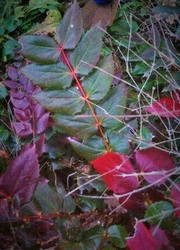


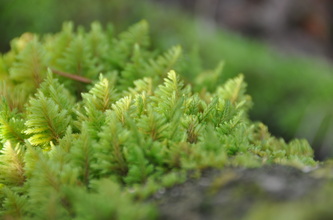
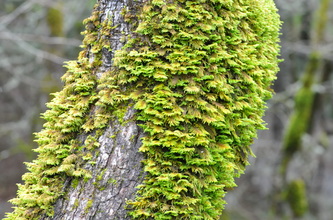




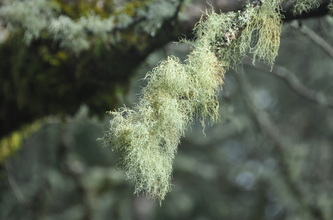
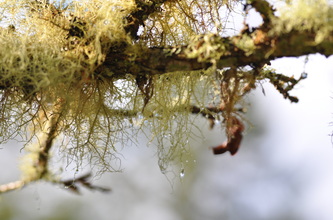
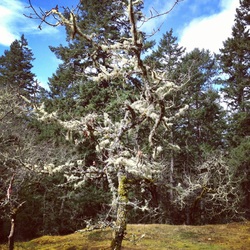
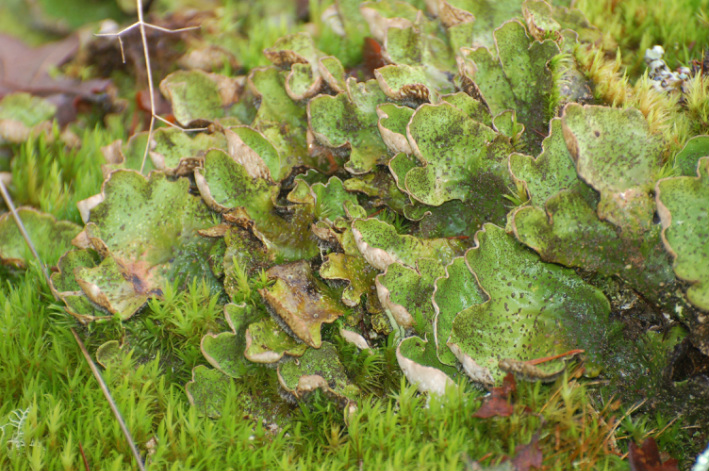

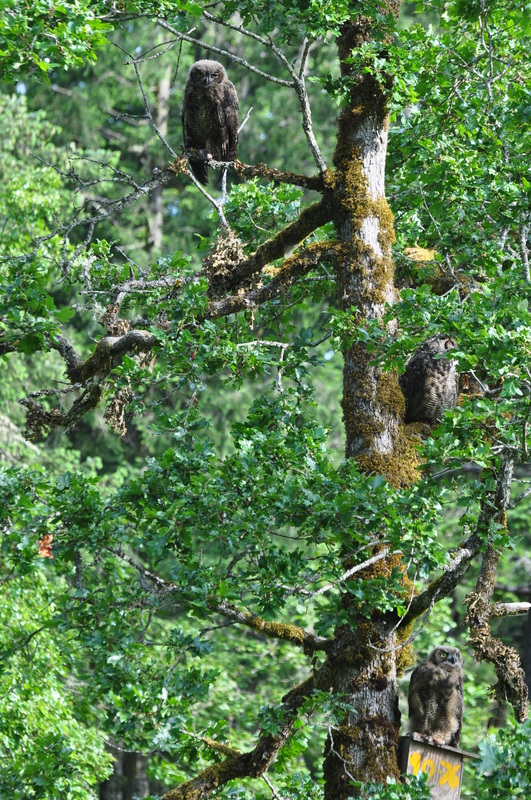
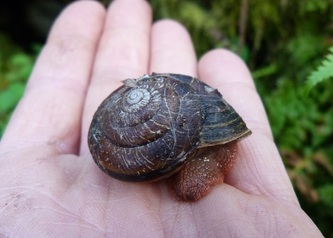
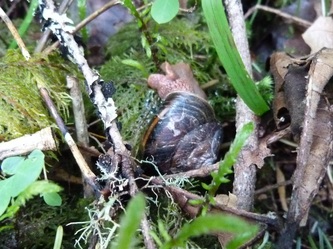
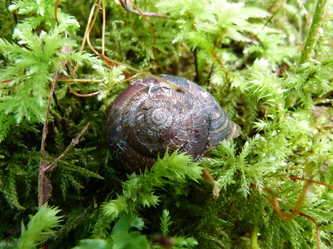


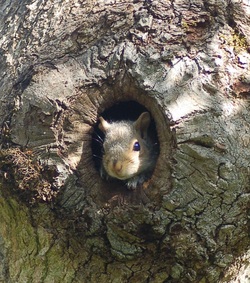
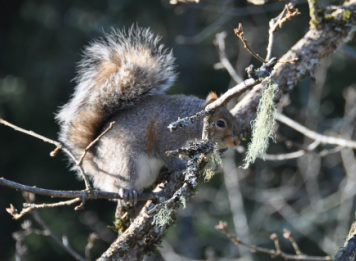


 RSS Feed
RSS Feed